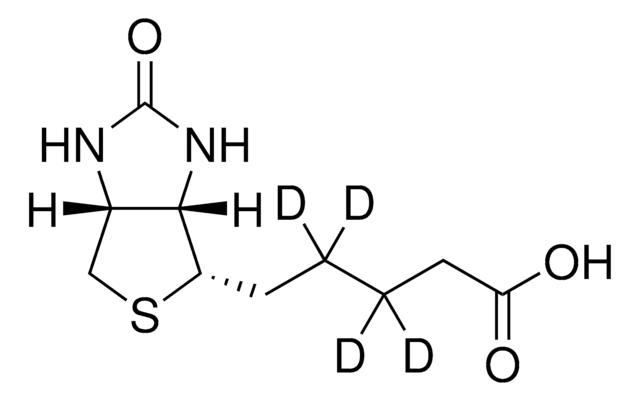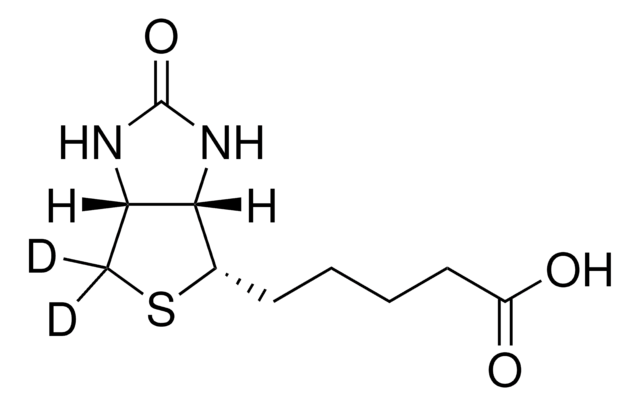809608
Biotin-2′,2′,3′,3′-d4
≥98 atom % D, ≥95% (CP)
Synonym(s):
Vitamin B7-d4, Vitamin B8-d4, Vitamin H-d4
Select a Size
About This Item
Recommended Products
isotopic purity
≥98 atom % D
Quality Level
Assay
≥95% (CP)
form
powder
technique(s)
mass spectrometry (MS): suitable
color
white to off-white
mp
228 °C
mass shift
M+4
storage temp.
−20°C
SMILES string
OC(CC([2H])([2H])C([2H])([2H])C[C@@H]1SC[C@@]2([H])[C@]1([H])NC(N2)=O)=O
Related Categories
1 of 4
This Item | 705268 | B6396 | 491527 |
|---|---|---|---|
| mass shift M+4 | mass shift M+2 | mass shift - | mass shift M+4 |
| isotopic purity ≥98 atom % D | isotopic purity ≥98 atom % D | isotopic purity - | isotopic purity 98 atom % D |
| technique(s) mass spectrometry (MS): suitable | technique(s) mass spectrometry (MS): suitable | technique(s) - | technique(s) - |
| assay ≥95% (CP) | assay ≥97% (CP) | assay ≥93% | assay - |
| Quality Level 200 | Quality Level 200 | Quality Level 200 | Quality Level 200 |
| form powder | form powder | form powder | form - |
General description
Biotin-2′,2′,3′,3′-d4 is an isotope of vitamin B7 wherein C-2′, C-2′, C-3′, C-3′ protons are replaced by deuterium.
Application
Storage Class Code
11 - Combustible Solids
WGK
WGK 1
Flash Point(F)
Not applicable
Flash Point(C)
Not applicable
Choose from one of the most recent versions:
Already Own This Product?
Find documentation for the products that you have recently purchased in the Document Library.
Articles
Transformation is the process by which exogenous DNA is introduced into a cell, resulting in a heritable change or genetic modification. This was first reported in Streptococcus pneumoniae by Griffith in 1928. Transforming principle of DNA was demonstrated by Avery et al. in 1944.
Technical Article on yeast media. Yeasts are eukaryotic microorganisms whose genomes have been comprehensively studied and some have been sequenced.
The development of genetic engineering and cloning has opened many possibilities of expression and isolation of heterologous proteins for research purposes. Considerable advances in technology have enabled expression and isolation of recombinant proteins in large scale.
Protocols
Yeasts are considered model systems for eukaryotic studies as they exhibit fast growth and have dispersed cells.
Yeast Drop Out Bulletin. The selection of plasmids in yeast is based on the use of auxotrophic mutant strains, which cannot grow without a specific medium component (an amino acid, purine or pyrimidine). Transformation with a plasmid containing the mutated gene enables the transformant to grow on a medium lacking the required component. Although yeast can grow on a synthetic medium without any amino acids, better yield and growth rate can be achieved on richer media.
Yeasts are considered model systems for eukaryotic studies as they exhibit fast growth and have dispersed cells. Yeast cultures can be grown, maintained, and stored in liquid media or on agar plates using techniques similar to those for bacterial cultures.
Our team of scientists has experience in all areas of research including Life Science, Material Science, Chemical Synthesis, Chromatography, Analytical and many others.
Contact Technical Service









